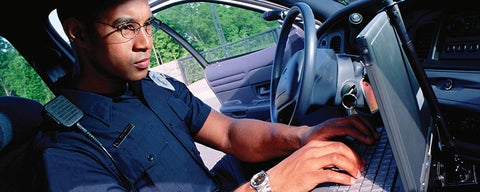
Police officers can spend an average of four hours in a 12-hour shift engaged in computer and data entry in their police cruisers. The steering wheel is in front of them, but their seats cannot be pushed back completely since there is a safety barrier behind the seats. Due to the restriction of space, their laptop computers are mounted to the side. This requires twisted and awkward body positions during computer work.
Moreover, police officers wear heavy duty belts. These hold their holster, gun, bullets, flashlight, keys, handcuffs and sometimes a spray, batons and duty weapons. A duty belt can sometimes hold up to as much as 15 pounds of equipment. These are worn even for in-vehicle police work.
Not surprisingly, there has been a lot of speculation about the impact of these physical exposures on musculoskeletal pain and injury among police officers.
Drs. Jack Callaghan and Clark Dickerson and graduate student Colin McKinnon from the Centre of Research Expertise for the Prevention of Musculoskeletal Disorders (CRE-MSD) were invited by the Municipal Health and Safety Association of Ontario, now the Public Services Health & Safety Association, to help them address reports of pain and discomfort by officers. The Windsor Police Service, the Waterloo Regional Police Service and York Regional Police enthusiastically joined the project. A CRE-MSD seed grant allowed a rapid response to the stakeholders’ concerns.
In order to determine the extent of the concern, they administered a questionnaire to officers asking them about their comfort in vehicles and their experience with in-vehicle computer systems and duty belts. Officers reported very high levels of discomfort in the lower back region due to the location and stiffness of the lumbar support, the use of the in-vehicle computer system, and from wearing duty belts.
Using video cameras in the police cruiser, the researchers identified common activities. They found that over the 12-hour shift, computer use was the most abundant in-vehicle, non-driving activity (22 per cent of in-vehicle time), confirming the importance of this activity.
A follow-up laboratory simulation of driving a police cruiser and interacting with a laptop showed that moving the laptop around within the constraints of current cruiser interiors was not helpful. This indicated that alternate technologies and interface approaches are required to address the MSDs associated with the job demands.
In order to address their seating problems, a car seat specially designed for the police cruiser has been tried out. The prototype seat included an active lumbar support that periodically changes shape. In addition, the seat included a shortened seat pan and structural modifications to provide active torso support and accommodate the police duty belt. It was found that the new seat reduced discomfort in the low back compared to the standard seat during both simulated driving and actual cruiser operation.
This project is a good example of how CRE-MSD researchers are responding to the needs of stakeholders. This interaction is a key goal for the Centre. Much of our research includes stakeholders who help define the research questions and are actively involved throughout the study.